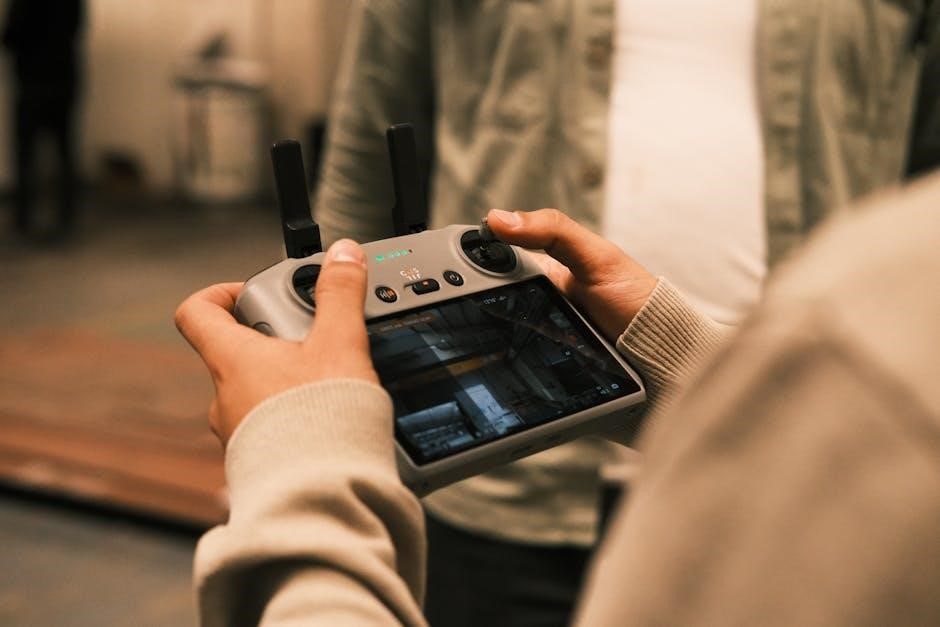Welcome to the One For All remote user guide! This comprehensive resource assists you in programming and utilizing your universal remote. Control your devices with ease, eliminating the need for multiple remotes.
The One For All remote is a universal remote control designed to simplify your home entertainment setup. It replaces multiple remotes, consolidating control into a single device. This guide provides comprehensive instructions on programming, troubleshooting, and maximizing its potential.
One For All remotes offer various programming methods, including SimpleSet for popular brands and direct code entry for specific devices. You can also utilize code search or online code finders to locate the appropriate codes for your equipment. Ensure your devices are powered on before programming.
With a One For All remote, you can control TVs, soundbars, DVD players, and more. This eliminates the clutter and confusion of managing multiple remotes. Follow the steps outlined in this guide to quickly and easily program your remote and enjoy seamless control of your home entertainment system.
Whether you’re a first-time user or looking to optimize your remote’s functionality, this guide is your go-to resource for all things One For All. Say goodbye to remote juggling and hello to streamlined control.
Programming Methods
One For All remotes offer diverse programming methods to accommodate various devices and user preferences. The SimpleSet feature provides a quick and easy setup for popular brands, streamlining the process for common devices. For less common brands or specific models, the direct code entry method allows manual input of device codes.
The code search method systematically scans through all available codes in the remote’s memory, attempting to identify the correct code for your device. This method is useful when the device brand is unknown or not listed. Online code finders offer an alternative, providing device codes based on make and model number.
Each programming method involves distinct steps, including entering setup mode, inputting the code, and testing its functionality. This guide provides detailed instructions for each method, ensuring a smooth and successful programming experience. Choose the method that best suits your device and technical expertise.
By mastering these programming methods, you can unlock the full potential of your One For All remote and enjoy seamless control of your entire home entertainment system. Selecting the right method can make all the difference.
SimpleSet Programming
SimpleSet programming offers the easiest method for setting up your One For All remote with popular brands. This method utilizes pre-programmed codes for common devices, streamlining the setup process and eliminating the need for manual code entry. To begin, identify if your device’s brand is supported by SimpleSet.
Consult the SimpleSet brand list in your remote’s user manual or online. If your brand is listed, locate the corresponding SimpleSet number. Usually, this involves pressing a single digit or a combination of device and power buttons. Follow the specific instructions for your remote model.
Point the remote at your device and initiate the SimpleSet sequence. The remote will send a series of pre-programmed codes. Observe your device for a response, such as turning off or changing channels. Once the device responds, immediately stop the sequence to save the correct code.
Test the remote’s functionality to ensure all features are working correctly. If some functions are missing or incorrect, repeat the SimpleSet process or try a different programming method. SimpleSet is an ideal option for basic setup with major brands.

Direct Code Entry Method
The direct code entry method allows programming by manually inputting a specific code for your device. This method offers broader compatibility than SimpleSet, working with numerous brands and device types.
Finding the Correct Code
To effectively program your One For All remote using the direct code entry method, finding the correct code for your specific device is crucial. Begin by consulting the code list included in your remote’s user manual. This list is organized by device type (e.g., TV, DVD player, audio receiver) and brand name. Locate your device’s brand and note the corresponding codes.
If your brand is not listed, consider using the code search method. This involves systematically trying different codes until you find one that works with your device. Online code finders are also available, allowing you to input your device’s make and model number to retrieve potential codes.
Remember that some brands may have multiple codes listed. Start with the most popular code and test it. If it doesn’t work, try the other codes listed for your brand. Patience is key, as finding the right code may require some trial and error. Once found, write it down for future reference.

Using the Code List
The code list is your primary resource for finding the correct codes to program your One For All remote. This list is typically found in the user manual that came with your remote. It is organized alphabetically by device type, such as TV, DVD player, streaming device, and audio receiver. Within each device type, the brands are also listed alphabetically.
To use the code list effectively, first identify the type of device you want to control (e.g., TV). Then, locate the brand name of your device within the corresponding section. Once you find your brand, you will see a list of codes associated with it. Note that some brands may have multiple codes listed.
When multiple codes are available, it is recommended to start with the first code listed, as it is often the most common or popular code. If the first code doesn’t work, systematically try the other codes listed for your brand until you find one that successfully operates your device. Keep a record of the code that works for future reference.

Code Search Method
The code search method is a useful alternative when you cannot find your device’s brand listed in the code list or when none of the listed codes seem to work. This method involves systematically cycling through all the codes stored in the One For All remote’s memory until you find one that operates your device.
To initiate the code search, first, ensure your device is powered on. Then, follow the instructions in your remote’s user manual to enter the code search mode. This typically involves pressing and holding a specific button or combination of buttons on the remote.
Once in code search mode, the remote will begin sending out signals corresponding to different codes. You will usually need to press a button, such as the “Channel Up” button, to advance to the next code. Keep pressing this button repeatedly, and carefully observe your device. When your device responds, such as turning off or changing channels, immediately press the “OK” or “Enter” button to lock in that code. This confirms that you have found a compatible code for your device.
Online Code Finders
If you’re struggling to find the correct code, online code finders are a valuable resource. These tools often require you to input your device’s brand and model number to suggest compatible codes.
Programming Steps
Programming your One For All remote involves a few key steps. First, ensure your device is powered on. Then, identify the correct programming method: SimpleSet or direct code entry. SimpleSet is ideal for popular brands and uses pre-programmed codes. Direct code entry requires finding the specific code for your device’s brand from the code list.
Regardless of the method, you’ll typically need to enter setup mode. This usually involves pressing and holding the “SET” or “MAGIC” button until the indicator light illuminates. Next, input the code using the numeric keypad. After entering the code, test the remote’s functionality by trying basic commands like power, volume, and channel changing.
If the device responds correctly, the programming is successful. If not, try another code from the list or explore the code search method. Remember to consult your One For All remote’s user manual for specific instructions and troubleshooting tips.
Entering Setup Mode
Entering setup mode is a crucial step in programming your One For All remote. This mode allows the remote to accept new device codes. The method for entering setup mode can vary slightly depending on your specific One For All remote model, so consulting your user manual is always recommended.
Generally, you’ll need to locate the “SET,” “MAGIC,” or “SETUP” button on your remote. Press and hold this button. While holding the button, you may also need to press the device button (TV, DVD, etc.) you wish to program simultaneously. Continue holding both buttons until the indicator light on the remote illuminates and remains lit or blinks, signaling that the remote has successfully entered setup mode.
Once in setup mode, you can proceed to input the device code using the numeric keypad. Be sure to release the buttons after the indicator light signals the remote is ready to receive the code. If the light does not illuminate or blink, repeat the process, ensuring you are pressing the correct buttons and holding them for the appropriate duration.
Inputting the Code
After successfully entering setup mode, the next crucial step is inputting the correct code for your device. This code tells the One For All remote how to communicate with your TV, DVD player, or other device. Locate the appropriate code for your device’s brand and type in the code list provided with your remote, or use an online code finder.
Using the numeric keypad on your One For All remote, carefully enter the digits of the code. Double-check the code before entering it to avoid errors. Some remotes may require you to press an “OK” or “Enter” button after inputting the code. If your remote has such a button, press it after entering the code.
The indicator light on the remote may blink or turn off to confirm that the code has been received. If the light does not respond, try re-entering the code, ensuring each digit is entered correctly. If the issue persists, try a different code listed for your device brand or explore the code search method. Accuracy is key during this step.

Testing the Code
After inputting the code, test the remote by trying basic functions like power, volume, and channel changing. If these work, the code is correct. If not, try another code.
Troubleshooting Common Issues
Encountering problems with your One For All remote is not uncommon, but fortunately, many issues can be resolved with simple troubleshooting steps. This section addresses several common problems users face and offers practical solutions to get your remote working correctly.
One frequent issue is the remote not responding at all. This could stem from several causes, such as dead batteries, incorrect programming, or even physical obstructions blocking the signal. Ensuring fresh batteries are installed is the first step.
Another common problem is the remote using an incorrect code, resulting in limited or no functionality. Furthermore, problems with programming like forgetting to hold the set up button can cause issues. By systematically addressing these potential causes, you can often restore full functionality to your One For All remote.
Remote Not Responding
When your One For All remote fails to respond, it can be frustrating. However, several factors can cause this issue, and systematically checking each one can help you identify the problem and restore functionality.
First, ensure the batteries are fresh and correctly installed. Weak or depleted batteries are a common cause of remote failure. Replace them with new batteries of the correct type, making sure to align the polarity (+ and -) as indicated in the battery compartment.
Next, check for any obstructions between the remote and the device you are trying to control. Ensure a clear line of sight, as objects can block the infrared signal. Also, confirm that the device is powered on and properly connected to a power source.
If the problem persists, attempt to reprogram the remote with the correct code for your device. Refer to the code list or online database to find the appropriate code and follow the programming instructions carefully.
Incorrect Code
Encountering an incorrect code during the programming of your One For All remote can be a common hiccup. If your remote isn’t controlling your device correctly, it could be due to using the wrong code. Don’t worry; there are several ways to resolve this issue and find the right code.
First, double-check the code you’ve entered against the code list provided with your remote or available online. Ensure you’ve selected the correct device type and brand. A simple typo can lead to an incorrect code.
If you’re confident the code is correct but still not working, try other codes listed for your device brand. Manufacturers often use multiple codes, and one may work better than another. You can also try the code search method, allowing the remote to cycle through codes until you find one that works.
If all else fails, visit the One For All website or contact their customer support. They may have updated code lists or be able to provide specific troubleshooting assistance for your device.
Low Battery
A common culprit behind a malfunctioning One For All remote is low battery power. When the batteries are weak, the remote may exhibit erratic behavior, fail to respond, or have a significantly reduced range. Replacing the batteries is often the simplest and most effective solution.
Start by opening the battery compartment, usually located on the back of the remote. Remove the old batteries and replace them with fresh ones of the correct type (typically AAA or AA). Ensure the batteries are inserted with the correct polarity, matching the “+” and “-” markings inside the compartment.
After replacing the batteries, test the remote to see if it functions properly. If the issue persists, double-check that the batteries are new and have sufficient charge. Sometimes, even new batteries can be defective. If you’re still experiencing problems, consider cleaning the battery contacts inside the compartment with a cotton swab dipped in rubbing alcohol to remove any corrosion or debris that may be hindering the connection.
If the remote continues to malfunction after these steps, it may indicate a more serious issue requiring further troubleshooting.



